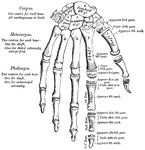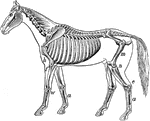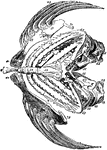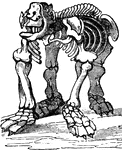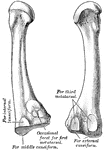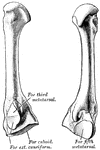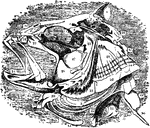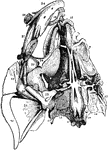
Frontal Bone of the Human Skull
Frontal bone of the human skull, outer surface. The frontal bone forms the forehead, roof of the orbital…
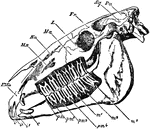
Horse Skull
"Side view of skull of horse, with the bone removed so as to expose the whole of the teeth. PMx, premaxilla;…

Howling Monkey Skull
"Side views of skull and hyoid bone of Howling Money." — Encyclopedia Britanica, 1893

Human Leg (Front View), and Comparative Diagrams showing Modifications of the Leg
This illustration shows a human leg (front view), and comparative diagrams showing modifications of…
Humerus
"The humerus, a long, hollow bone, rests against a shallow socket on the shoulder blade. It…
Humerus
"The humerus, which moves freely by a globular head upon the scapula, forming the shoulder-joint." —…
The Human Humerus
The human humerus bone, the longest and largest bone of the upper leg. Labels: a, rounded head; gt,…
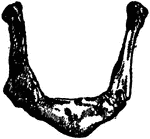
Human Hyoid Bone
The hyoid, os hyoides, or tongue bone, is an isolated, U-shaped bone lying in front of the throat, just…
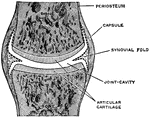
A Simple Complete Joint
A simple complete joint, one type of movable articulation. The synovial membrane is represented by dotted…
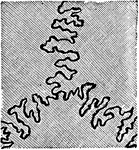
Human Joint, Dentated Suture
A toothed, or dentated suture. This is one type of immovable articulation. It is found in the union…

Elbow Joint
"Showing how the Ends of the Bones are shaped to form the Elbow Joint. The cut ends of a few ligaments…

Human Joint, Mixed Articulation
A mixed articulation (slightly movable). In this form, the bony surfaces are usually joined together…

Section of the Knee
This illustration shows a section on the knee (A, Femur; B, Tibia; C, Patella; D, Synovial sac; E, bursæ).…

Human Lachrymal Facial Bone
Lachrymal Bone. The lachrymal are the smallest and most fragile bones fo the face. They are situated…

Lamellae
Lamellae torn off from a decalcified human parietal bone at some depth from the surface. Labels: a,…
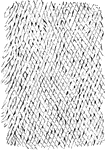
Reticular Structure of a Lamellae
Shown is a thin layer peeled off from a soft bone, which is intended to represent the reticular structure…

Leg Bones
"Bones of the leg. a, femur; b, tibia; c, fibula; d, tarsal bones; e, metatarsal bones; f, phalanges;…
Cross-section from a shaft of a long bone
"Little openings (Haversian canals) are seen, and around them are arranged rings of bone with little…
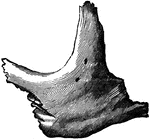
Human Malar (Cheek) Bone
Malar (cheek) bone. The malar bones form the prominence of the cheek, and part of the outer wall and…
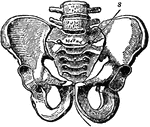
Pelvic Bone, Male
A bony structure located at the bottom of the spine. The human sacrum forms the back part of the pelvis,…
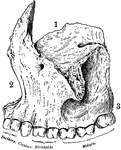
Human Maxillary (Upper Jaw) Bone
Superior maxillary bone. With it's fellow on the opposite side, it forms the whole of the upper jaw.…

Human Maxillary (Upper Jaw) Bone
Inferior Maxillary Bone (lower jaw). It is the largest and strongest bone in the face and serves for…

Moa skeleton
The partial skeleton of a moa, an enormous flightless bird once native to New Zeland, now extinct.

Human Nostril Bone
Inferior turbinated bone, convex surface. The inferior turbinated bones are situated on the outer wall…
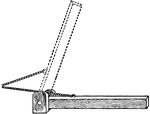
Oblique Pull
"It is worthy of note that, owing to the oblique direction in which the muscles are commonly inserted…
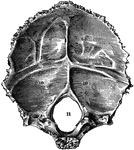
Occipital Bone of the Human Skull
Occipital bone of the human skull, inner surface. It is situated at the back and base of the skull.…
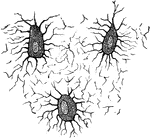
Osteoblasts
Nucleated none cells (osteoblasts) and their processes, contained in the one lacunae and their canaliculi…
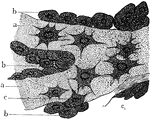
Osteoblasts from Embryo
Osteoblasts from the parietal bone of a human embryo thirteen weeks old. Labels: a, bony septa with…
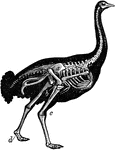
Skeleton of Ostrich
"Shows the powerful legs, small feet, and rudimentary wings of the bird; the obliquity at which the…
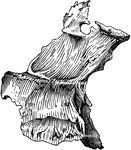
Human Palate Bone
Palate bone. Palate bones form the back part of the roof of the mouth; part of the floor and outer wall…
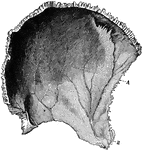
Parietal Bone of the Human Skull
Parietal bone of the human skull, inner surface. The parietal bones form the greater part of the sides…
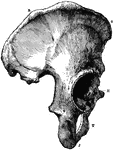
Part of the Human Pelvic Bone
The Os Innominatum, or nameless bone, so called from bearing no resemblance to any known object, is…

Human Pelvis, Male and Female
Male pelvis (top) and female pelvis (bottom). The pelvis is stronger and more massively constructed…

Perch skeleton
"The bones of fishes are of a less dense and compact nature than in the higher order of animals; in…

Perissodactyle
"Bones of the fore foot of existing Perissodactyle. Tapir (Tapirus indicus)." —The Encyclopedia…

Perissodactyle
"Bones of the fore foot of existing Perissodactyle. Rhinoceros (Rhinoceros Sumairensis)." —The…

Pike Scapulocoracoid
"Pectoral arch and fore limb of the pike (Esox lucius), an osseous fish, showing scapulocoracoid, composed…

Broken Radius
"When a bone is broken, blood trickles out between the injured parts, and afterwards gives place to…

Scapula
"The shoulder-blade is a large, flat, three-sided bone, which is placed on the upper and back…

The Human Scapula
The human scapula bone (shoulder blade). Labels: 1, glenoid cavity; 2, end of the spine of scapula.

Leg of Seal
This illustration shows the leg of a seal. P. Pelvis, FE. Femur, TI. Tibia, FI. Fibula, TA. Tarsus,…

Section of Human Kidney
This illustration shows a section of a human kidney (A, Cortical substance; B, Pyramids; C, Hilum; D,…
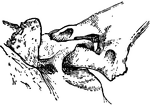
Shackle Joint from the Exoskeleton of a Siluroid Fish
"A joint involving the principle of the shackle. Specifically, in anatomy, a kind of articulation found…


